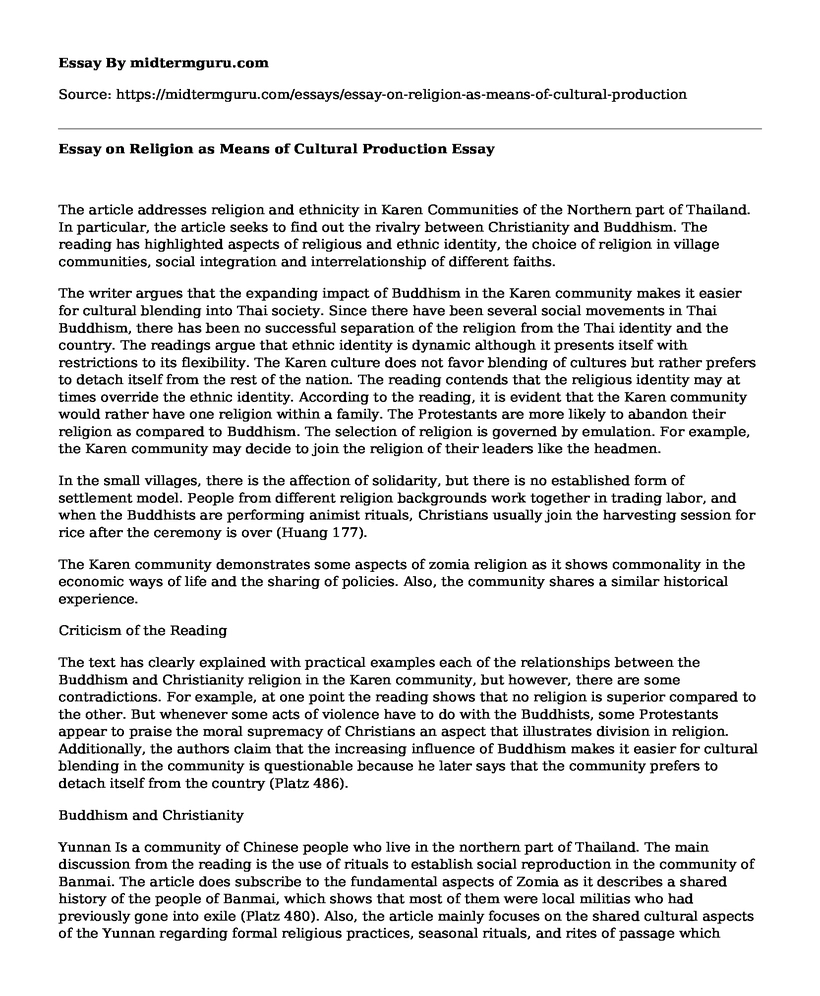The article addresses religion and ethnicity in Karen Communities of the Northern part of Thailand. In particular, the article seeks to find out the rivalry between Christianity and Buddhism. The reading has highlighted aspects of religious and ethnic identity, the choice of religion in village communities, social integration and interrelationship of different faiths.
The writer argues that the expanding impact of Buddhism in the Karen community makes it easier for cultural blending into Thai society. Since there have been several social movements in Thai Buddhism, there has been no successful separation of the religion from the Thai identity and the country. The readings argue that ethnic identity is dynamic although it presents itself with restrictions to its flexibility. The Karen culture does not favor blending of cultures but rather prefers to detach itself from the rest of the nation. The reading contends that the religious identity may at times override the ethnic identity. According to the reading, it is evident that the Karen community would rather have one religion within a family. The Protestants are more likely to abandon their religion as compared to Buddhism. The selection of religion is governed by emulation. For example, the Karen community may decide to join the religion of their leaders like the headmen.
In the small villages, there is the affection of solidarity, but there is no established form of settlement model. People from different religion backgrounds work together in trading labor, and when the Buddhists are performing animist rituals, Christians usually join the harvesting session for rice after the ceremony is over (Huang 177).
The Karen community demonstrates some aspects of zomia religion as it shows commonality in the economic ways of life and the sharing of policies. Also, the community shares a similar historical experience.
Criticism of the Reading
The text has clearly explained with practical examples each of the relationships between the Buddhism and Christianity religion in the Karen community, but however, there are some contradictions. For example, at one point the reading shows that no religion is superior compared to the other. But whenever some acts of violence have to do with the Buddhists, some Protestants appear to praise the moral supremacy of Christians an aspect that illustrates division in religion. Additionally, the authors claim that the increasing influence of Buddhism makes it easier for cultural blending in the community is questionable because he later says that the community prefers to detach itself from the country (Platz 486).
Buddhism and Christianity
Yunnan Is a community of Chinese people who live in the northern part of Thailand. The main discussion from the reading is the use of rituals to establish social reproduction in the community of Banmai. The article does subscribe to the fundamental aspects of Zomia as it describes a shared history of the people of Banmai, which shows that most of them were local militias who had previously gone into exile (Platz 480). Also, the article mainly focuses on the shared cultural aspects of the Yunnan regarding formal religious practices, seasonal rituals, and rites of passage which include funerals, weddings, and initiation.
From the readings, we learn that the rituals have managed to unite the people of Yunnan and therefore can get their spiritual needs at different positions of family, individual and the entire society. Furthermore, the work outlines four evolutionary types of spiritual development which include peasant religion, feudal religion, the official religion and religious revivals. We also see that the Chinese religion is partitioned into two main types which are the institutional religions which are Christianity, Islam, and Buddhism among others and the professional religions that perform rituals.
In a way, the argument sounds to be a bit circular as it only revolves around the aspect of rituals in the community and fails to articulate the issue with other factors that affect the society like the policy formulation and implementation (Feuchtwang 54). However, the article can be praised for the ability to comprehensively elaborate in details the main interest of the people of Yunnan which is to achieve social reproduction.
Comparison of the two Articles
There is a similarity that depicts the elements of Zomia between the two materials as both articles describe the unique cultures that are shared among people in each of the two communities. However, there is a difference between the reports two articles. The argument about the Karen community mainly concentrates on religion and ethnicity while the discussion about the Yunnan people focused on religion and popular rituals practiced in the community.
Work Cited
Feuchtwang, Stephan. The imperial metaphor: popular religion in China. Other, 1992.Platz, Roland. "Buddhism and Christianity in competition? Religious and ethnic identity in Karen communities of Northern Thailand." Journal of Southeast Asian Studies 34.03 (2003): 473-490.
Huang, Shu-min. "Religion as a means of cultural reproduction: popular rituals in a Yunnan Chinese village in northern Thailand." Asian Ethnicity 10.2 (2009): 155-176.
Cite this page
Essay on Religion as Means of Cultural Production. (2021, Jul 01). Retrieved from https://midtermguru.com/essays/essay-on-religion-as-means-of-cultural-production
If you are the original author of this essay and no longer wish to have it published on the midtermguru.com website, please click below to request its removal:
- Brief Retelling of Parables
- Emotion and Culture Essay Sample
- Essay on Philosophy of Theodicy
- The Separation of Church and the State - Essay Sample
- Essay Sample on Diversity in the Medical Office
- Essay Sample on The Encounter of the Muslim World with the Modern West
- Searching for Inner Redemption: A Christian's Journey - Essay Sample







